Ware C. Information Visualization: Perception for Design
Подождите немного. Документ загружается.

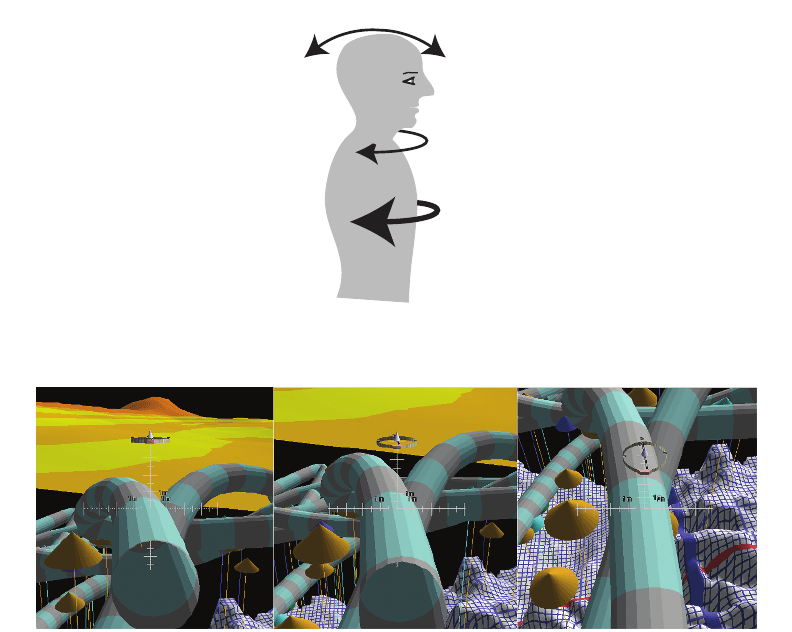
As we explore the world, we change our egocentric viewpoint primarily around two axes of
rotation. We turn our bodies mostly around a vertical axis (pan) to change heading, and swivel
our heads on the neck (also pan) about a similar vertical axis for more rapid adjustments in view
direction. We also tilt our heads forward and back, but generally not to the side (roll). Thus,
human angle of view control normally has only two degrees of freedom. These heading (pan)
and tilt rotational degrees of freedom are illustrated in Figure 10.7.
A consequence of the fact that we are most familiar with only two of the three degrees of
freedom of viewpoint rotation is that when displaying maps, either real or in a virtual environ-
ment, we are most comfortable with only two degrees of freedom of rotation. Figure 10.8 illus-
334 INFORMATION VISUALIZATION: PERCEPTION FOR DESIGN
Pan
Tilt
Figure 10.7 Primary rotation axes of egocentric coordinates.
Figure 10.8 View-control widgets for examining geographic data. Note that the rotational degrees of freedom match
the rotational degrees of freedom of egocentric coordinates. The three views show different amounts of
tilt. The handle on the top widgets can be dragged left and right around the ring to change the view
heading.
ARE10 1/20/04 4:51 PM Page 334

trates an interface for rotating geographical information spaces constructed to have the same two
degrees of freedom (Ware et al., 2001). The widgets allow rotation around the center point (equiv-
alent to turning the body) and tilt from horizontal up into the plane of the screen (equivalent to
forward-and-back head tilt), but they do not allow rotation about the line of site through the
center of the screen (equivalent to the rarely used sideways head tilt).
Because we tend to move our bodies forward, and only rarely sideways, a simple interface
to simulate human navigation can be constructed with only three degrees of freedom, two for
rotations (heading and tilt) and one to control forward motion in the direction of heading. If a
fourth degree of freedom is added, it may be most useful to allow for something analogous to
head turning. This allows for sideways glances while traveling forward.
The term exocentric simply means external. In 3D computer graphics, exocentric frames of
reference are used for applications such as monitoring avatars in video games, controlling virtual
cameras in cinematography, and monitoring the activities of remote or autonomous vehicles.
Obviously, there is an infinity of exocentric views. The following is a list of some of the more
important and useful ones.
Another person’s view For some tasks, it can be useful to take the egocentric view of
someone else who is already present in our field of view. Depending on the angular
disparity in the relative directions of gaze, this can be confusing, especially when the other
person is facing us. In the ClearBoard system (Ishii and Kobayashi, 1992), a remote
collaborator appeared to be writing on the other side of a pane of glass. By digitally
reversing the image, a common left–right frame of reference was maintained.
Over-the-shoulder view A view from just behind and to the side of the head of an
individual. This view is commonly used in cinematography.
God’s-eye view Following a vehicle or avatar from above and behind. Figure 10.9(a)
illustrates. This view is very common in video games. Because it provides a wider field of
Interacting with Visualizations 335
Figure 10.9 (a) God’s-eye view of a moving vehicle shown by the tube object in the foreground. (b) Wingman’s view of
the same vehicle.
ARE10 1/20/04 4:51 PM Page 335

view, it can be better for steering a remote vehicle than the more obvious choice, an
egocentric view from the vehicle itself (Wang and Milgram, 2001).
Wingman’s view Following a vehicle or avatar while looking at it from the side. Figure
10.9(b) illustrates. Exocentric views that follow a moving object, such as the God’s-eye or
wingman’s views, are sometimes called tethered (Wang and Milgram, 2001).
Map view A top-down view.
Whether an egocentric or an exocentric frame of reference is likely to be most useful depends on
the task (McCormick et al., 1998). Some tasks, such as steering a virtual vehicle, are better done
with an egocentric view or an exocentric God’s-eye tethered view. Other tasks involving global
spatial awareness, such as estimating the distance between a set of objects, can be performed
better with an exocentric map view.
If we have multiple views simultaneously, then the links between views can be made
visually explicit (Ware and Lewis, 1995; Plumlee and Ware, 2003). Figure 10.10 illustrates
336 INFORMATION VISUALIZATION: PERCEPTION FOR DESIGN
Figure 10.10 The subwindow in the upper left corner provides a tethered view. The overview contains a number of
graphical devices to make the tethering explicit (Plumlee and Ware, 2003).
ARE10 1/20/04 4:51 PM Page 336
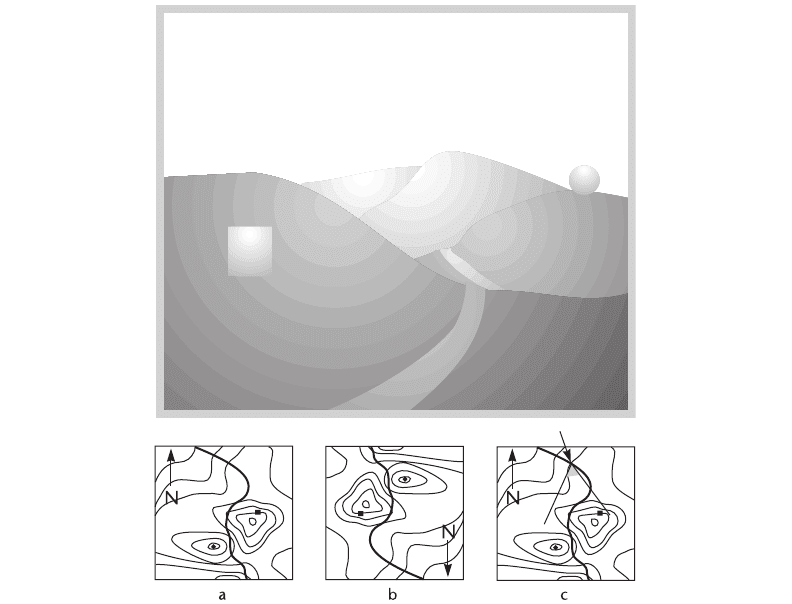
graphical methods for showing where the tethered view is with respect to a larger overview. These
include a viewpoint proxy, a transparent pyramid showing the direction and angle of the
tethered view, and lines that visually link the secondary window with its source.
None of the exocentric views has been studied as much as the map view.
Map Orientation
How should a map be displayed? Two alternatives have been extensively studied: the track-up
display, shown in Figure 10.11(b), and the north-up display, shown in Figure 10.11(a). A track-
up map is oriented so that the straight-ahead direction, from the point of view of the navigator,
is the up direction on the map. The second alternative is to display the map so that north is
always up, at the top of the map.
Interacting with Visualizations 337
Figure 10.11 (a) North-up map. (b) Track-up map. (c) North-up map with user view explicitly displayed.
ARE10 1/20/04 4:51 PM Page 337
One way of considering the map orientation problem is in terms of control compatibility.
Imagine yourself in a car, driving south from Berlin, Germany, to Rome, Italy. With a north-up
map, a right turn becomes a left direction on the map. Many people find this confusing and reori-
ent the map, even though this means that the place names are upside-down. Experimental studies
of map use confirm this, showing that fewer errors are made when subjects use a track-up map
(Eley, 1988). However, the north-up map does have advantages. Expert navigators often prefer
this orientation because it provides a common frame of reference for communicating with
someone else.
It is possible to enhance a north-up map and make it almost as effective as a track-up map,
even for novices. Aretz (1991) provided a north-up map for helicopter navigators, but with the
addition of a clear indicator of the forward field of view of the navigator. This significantly
enhanced the ability of the user to orient himself or herself. Figure 10.11(c) illustrates this kind
of enhanced map.
Supporting Visualizations with Maps
The research suggests a number of ways that visualizations can be enhanced with maps:
•
Overview maps should be provided when an information space is large. Given how hard
it is to build up a mental map by exploring an environment, an overview can substantially
reduce the cognitive load.
•
User location and direction of view within the map should be indicated. A common way
of doing this is with a You are here arrow.
•
Imagery of key landmarks should be provided. A landmark image on a map should be
constructed from a viewpoint that will occur when the wayfinder encounters the actual
landmark.
It should be borne in mind that procedural instructions can be more useful than a map when the
task itself requires navigating from landmark to landmark. In this case, the cognitive represen-
tation of the task is likely to be topological. If the problem is to guide a user from node to node
through a virtual information space, providing a sequence of instructions may be more appro-
priate than providing a map. A verbal or written set of procedural instructions can also be
enhanced with landmark imagery.
Focus, Context, and Scale
We have been dealing with the problem of how people navigate through 3D data spaces, under
the assumption that the methods used should reflect the way we navigate in the real world. The
various navigation metaphors are all based on this assumption. However, there are a number of
successful spatial navigation techniques that do not use an explicit interaction metaphor, but do
involve visual spatial maps. These techniques make it easy to move rapidly between views at dif-
ferent scales; because of this, they are said to solve the focus–context problem. If we think of the
338 INFORMATION VISUALIZATION: PERCEPTION FOR DESIGN
ARE10 1/20/04 4:51 PM Page 338
problem of wayfinding as one of discovering specific objects or locations in a larger landscape,
the focus–context problem is simply a generalization of this, the problem of finding detail in a
larger context. The focus–context problem is not always spatial; there are also structural and
temporal variations.
Spatial scale Spatial-scale problems are common to all mapping applications. For example, a
marine biologist might wish to understand the spatial behavior of individual codfish
within a particular school off the Grand Banks of Newfoundland. This information is
understood in the context of the shape of the continental shelf and the boundary between
cold Arctic water and the warm waters of the Gulf Stream.
Structural scale Complex systems can have structural components at many levels. A
prime example is computer software. This has structure within a single line of code,
structure within a subroutine or procedure (perhaps 50 lines of code), structure at the
object level for object-oriented code (perhaps 1000 lines of code), structure at the packet
level, and structure at the system level. Suppose that we wish to visualize the structure of
a large program, such as a digital telephone switch (comprising as many as 20 million
lines of code); we may wish to understand its structure through as many as six levels of
detail.
Temporal scale Many data visualization problems involve understanding the timing of events
at very different scales. For example, in understanding data communications, it can be
useful to know the overall traffic patterns in a network as they vary over the course of a
day. It can also be useful to follow the path of an individual packet of information
through a switch over the course of a few microseconds.
It is worth noting that the focus–context problem has already been solved by the human visual
system. The brain continuously integrates detailed information from successive fixations of the
fovea with the less detailed information that is available at the periphery. This is combined with
data coming from the prior sequence of fixations. For each new fixation, the brain must somehow
match key objects in the previous view with those same objects moved to new locations. Differ-
ing levels of detail are supported in normal perception because objects are seen at much lower
resolution at the periphery of vision than in the fovea. Because we have no difficulty in recog-
nizing objects at different distances, this also means that scale-invariance operations are sup-
ported in normal perception. The best solutions to the problem of providing focus and context
in a display are likely to take advantage of these perceptual capabilities.
Although the spatial scale of a map, the structural levels of detail of a computer program,
and the temporal scale in communications monitoring are very different application domains,
they can all be represented by means of spatial layouts of data and they belong to a class
of related visualization problems. The same interactive techniques can usually be applied. In
the following sections, we consider the perceptual properties of four different visualization
techniques to solve the focus–context problem: distortion, rapid zooming, elision, and multiple
windows.
Interacting with Visualizations 339
ARE10 1/20/04 4:51 PM Page 339
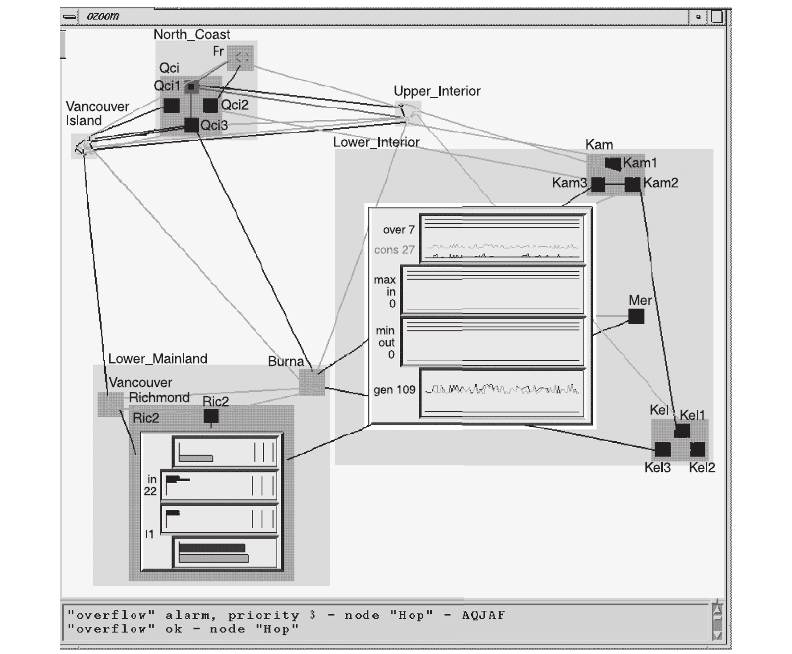
340 INFORMATION VISUALIZATION: PERCEPTION FOR DESIGN
Distortion Techniques
A number of techniques have been developed that spatially distort a data representation, giving
more room to designated points of interest and decreasing the space given to regions away from
those points. What is of specific interest is spatially expanded at the expense of what is not, thus
providing both focus and context. Figure 10.12 illustrates one such method, called intelligent
zooming (Bartram et al., 1994). Parts of the graph are dynamically repositioned and resized based
on selected points of interest, and selected nodes are expanded to show their contents. Some tech-
niques have been designed to work with a single focus, such as the hyperbolic tree browser
(Lamping et al., 1995), shown in Figure 10.13. Others allow multiple foci to be simultaneously
expanded, for example, the table lens (Rao and Card, 1994) illustrated in Figure 10.14. Many
Figure 10.12 A view of the intelligent zoom system developed by Bartram et al. (1998).
ARE10 1/20/04 4:52 PM Page 340
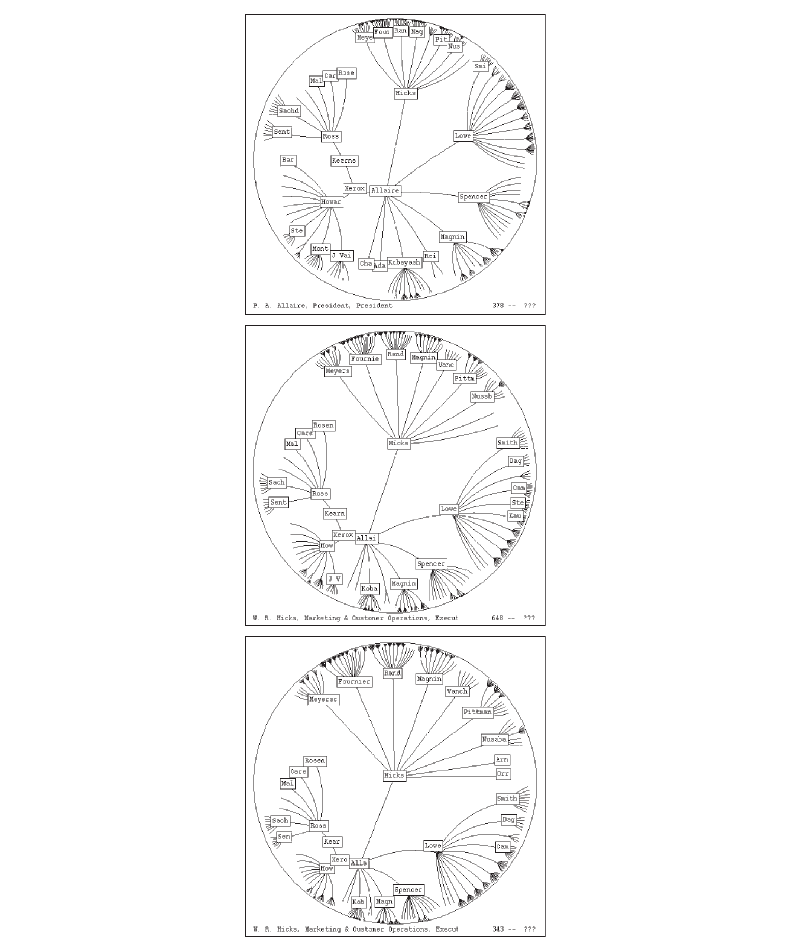
Interacting with Visualizations 341
Figure 10.13 Hyperbolic tree browser from Lamping et al. (1995). The focus can be changed by dragging a node from
the periphery into the center.
ARE10 1/20/04 4:52 PM Page 341
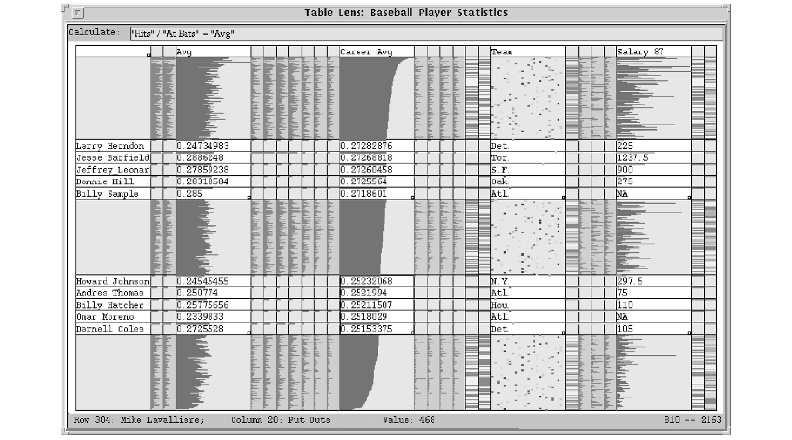
of these methods use simple algebraic functions to distort space based on the distance from each
focus.
An obvious perceptual issue related to the use of distorting focus–context methods is whether
the distortion makes it difficult to identify important parts of the structure. This problem can be
especially acute when actual geographical maps are expanded. For example, Figure 10.15 from
Sarkar and Brown (1994) shows a distorted view of a map of major cities in North America,
together with communications paths between them. The focus is on St. Louis, with the graph
expanded at that point, whereas all other regions are reduced in size. The result achieves the goal
of making the information about St. Louis and neighboring cities clearer, at the expense of an
extreme distortion of the shape of the continent. Compromises are possible; Bartram et al. (1994)
do not distort the focal information locally presented in the graph nodes, but they do distort the
overall graph layout (see Figure 10.12).
Rapid Zooming Techniques
In rapid zooming techniques, a large information landscape is provided, although only a part of
it is visible in the viewing window at any instant. The user is given the ability to zoom rapidly
into and out of points of interest, which means that although focus and context are not simul-
taneously available, the user can move rapidly and smoothly from focus to context and back. If
342 INFORMATION VISUALIZATION: PERCEPTION FOR DESIGN
Figure 10.14 Table lens from Rao and Card (1994). Multiple row- and column-wise centers of focus can be created.
ARE10 1/20/04 4:52 PM Page 342

rapid smooth scaling is used, the viewer can perceptually integrate the information over time.
The Pad and Pad++ syastems (Bederson and Hollan, 1994) are based on this principle.
They provide a large planar data landscape, with an interface using a simple point-and-click
technique to move rapidly in and out. Care has been taken to make the animation smooth and
continuous.
Mackinlay et al. (1990) invented a rapid-navigation technique for 3D scenes that they called
point of interest navigation. This method moves the user’s viewpoint rapidly, but smoothly, to a
point of interest that has been selected on the surface of some object. At the same time, the view
direction is smoothly adjusted to be perpendicular to the surface. A variant of this is to base the
navigation on an object. Parker et al. (1998) developed a similar technique that is object- rather
than surface-based; clicking on an object scales the entire 3D “world” about the center of
that object while simultaneously bringing it to the center of the workspace. This is illustrated in
Figure 10.16.
In all these systems, the key perceptual issues are the rapidity and ease with which the view
can be changed from a focal one to an overview and back. Less than a second of transition time
is probably a good rule of thumb, but the animation must be smooth to maintain the identity of
objects in their contexts. To maintain a sense of location, landmark features should be designed
to be recognized consistently, despite large changes in scale.
Interacting with Visualizations 343
Figure 10.15 Fish-eye view of links between major American cities. The focus is on St. Louis (Sarkar and Brown
1994).
ARE10 1/20/04 4:52 PM Page 343
